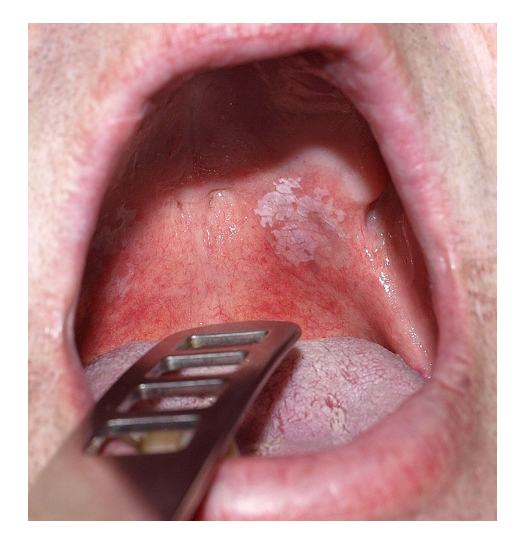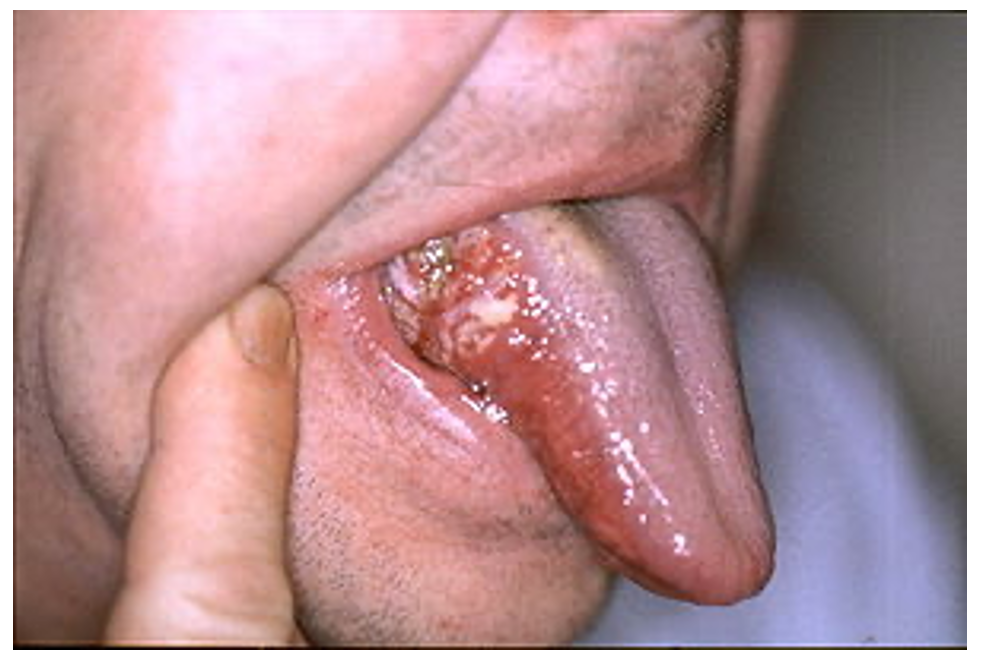Aphthous ulcer
This is a painful, superficial ulceration of the oral mucosa, which arises spontaneously and heals without scars
Whilst they are usually benign, it is essential to biopsy any ulcer not healing after 3 weeks to exclude malignancy
Symptoms
Appears like it has a grey base with surrounding erythema. Tender to touch and pain when eating
Management
Most self-resolve spontaneously
Can use topical anaesthetic or anti-inflammatory gels (Bongela) for symptomatic relief
Mumps
This is an infection due to the mumps virus that causes swelling of the parotid glands.
The virus is transmitted by respiratory droplets and infects respiratory tract cells before spreading to the parotid glands and other tissues.
The disease is now very rare due to the success of the MMR vaccine.
Symptoms
Fever, muscle pain, headache and malaise
Swelling of the parotid glands
Can affect testes (orchitis), pancreas (pancreatitis), CNS (aseptic meningitis)
Can lead to hearing loss (typically unilateral)

Complications
Orchitis (inflammation of testes)
Pancreatitis
Hearing loss (usually unilateral)
Aseptic meningitis
Key tests
Raised serum amylase due to salivary gland/pancreas involvement
Management
Supportive management as it is a self-limiting condition
Leukoplakia
This is an mucosal white patch in the mouth that does not rub off.
It is usually seen in people who smoke, drink excessive alcohol and use betel nuts.
It is a premalignant lesion which can turn into squamous cell carcinoma.

Hairy leucoplakia
Squamous cell carcinoma
This is a malignant proliferation of the squamous cells lining the oral mucosa, usually on the floor of the mouth.
It is associated with tobacco use, alcohol excess, leucoplakia as well as human papilloma virus infections.
Risk factors
Tobacco and alcohol
Human Papillomavirus 16
Leucoplakia and Erythroplakia (red plaque)
Symptoms
An ulcer which does not heal
Mouth pain, progressive dysphagia as the tumour becomes larger

Key tests
Biopsy of lesion is diagnostic
CT/MRI imaging is used to stage the cancer
Management
Surgical removal with chemo/radiotherapy
Although most ulcers are benign, it is important to consider biopsy for any ulcer which does not heal after 3 weeks, as this could be a sign of cancer
Salivary Gland tumours
This is a group of tumours which arise from the salivary glands. Most occur in the parotid gland but can also occur in the submandibular or sublingual gland.
These are usually benign and more common in women, except Warthin’s tumour, which is more common in men.
Pleomorphic adenomas
These are benign tumours which present as a slow-growing, painless lump.
They occur due to epithelial duct cell proliferation, but these can become malignant and recur after surgery.
Parotid carcinomas present as hard, less mobile, painful lumps which can invade the facial nerve.
Parotid carcinomas
These are malignant tumours which are less common
They present as hard, less mobile, painful lumps which can invade the facial nerve
Warthin’s tumour
This is a type of lymphoma due to lymphocyte infiltration of the parotid gland.
They are benign and are soft, mobile, and usually occur in older males.
Key tests
Ultrasound, followed by fine needle aspiration to assess histology
If malignant, CT/MRI imaging is used for staging
Management
Surgical resection is definitive but involves risk of damage to the facial nerve as it splits within the parotid gland


